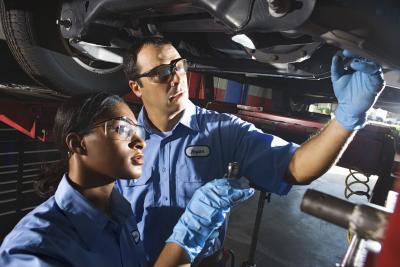
Leaks can occur in any number of places in the cooling system of your vehicle. These can range from an easy-to-fix aged hose to a difficult-to-replace cracked block. One of the more noticeable effects of coolant leakage is that your engine will overheat very easily. If your vehicle's coolant levels are consistently needing to be topped off, you more than likely have some sort of leak, even if it is just evaporation through an ill-fitting cap.
Laying under the vehicle using a flashlight will help you to see the hoses and valves on the underside of the vehicle better in order to spot possible leaks.
A radiator pressure gauge is a small hand-held device that allows to you test the radiator for leakage by testing the ability to hold at the correct pressure. On the radiator cap a pressure will be indicated, such as 12 pounds. Affixing the gauge to the opening and squeezing the hand pump up to the 12-pound pressure mark and waiting will allow you to see if there is the possibility for a leak. If the pressure holds steady for at least 10 minutes, there is a good chance there is no leak. However if the pressure drops bit by bit there is likely a leak.
This is attached to the radiator pressure gauge to test the cap for leakage. If the cap is not fitting properly, it can allow evaporation of coolant.
This is a tool used to find coolant leaks in a head gasket. This tool has a tube that is filled with a blue-colored testing liquid. This tube is affixed to the radiator opening. A bulb is attached to the reservoir and pumped to push air from the radiator into the tube where the testing fluid is contained. This liquid turns to yellow to indicate the presence of exhaust gases or remains blue if no gases are detected. The presence of exhaust gases within the radiator may indicate a coolant leak.
Leak detection dye is a colored dye that is safe to add to the coolant itself to make leaks easier to see. These dyes may be fluorescent and glow under exposure to UV lights. This can make detection of smaller leaks much easier.
A UV lamp is a lamp that gives off ultraviolet light that will show coolant leaks when used with a UV coolant dye.